遗传学整理
遗传学复习题整理
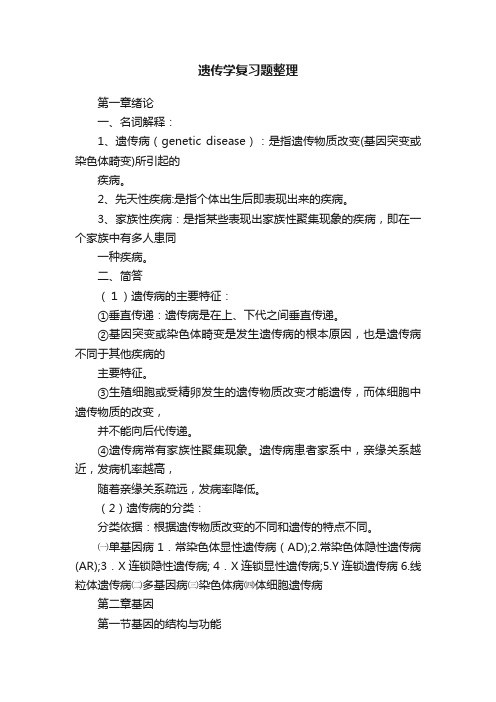
遗传学复习题整理第一章绪论一、名词解释:1、遗传病(genetic disease):是指遗传物质改变(基因突变或染色体畸变)所引起的疾病。
2、先天性疾病:是指个体出生后即表现出来的疾病。
3、家族性疾病:是指某些表现出家族性聚集现象的疾病,即在一个家族中有多人患同一种疾病。
二、简答(1)遗传病的主要特征:①垂直传递:遗传病是在上、下代之间垂直传递。
②基因突变或染色体畸变是发生遗传病的根本原因,也是遗传病不同于其他疾病的主要特征。
③生殖细胞或受精卵发生的遗传物质改变才能遗传,而体细胞中遗传物质的改变,并不能向后代传递。
④遗传病常有家族性聚集现象。
遗传病患者家系中,亲缘关系越近,发病机率越高,随着亲缘关系疏远,发病率降低。
(2)遗传病的分类:分类依据:根据遗传物质改变的不同和遗传的特点不同。
㈠单基因病1.常染色体显性遗传病(AD);2.常染色体隐性遗传病(AR);3.X连锁隐性遗传病; 4.X连锁显性遗传病;5.Y连锁遗传病6.线粒体遗传病㈡多基因病㈢染色体病㈣体细胞遗传病第二章基因第一节基因的结构与功能一、名词解释:1、基因(gene):是合成一种有功能的多肽链或者RNA分子所必需的一段完整的DNA序列。
2、断裂基因:真核生物结构基因的DNA顺序包括编码顺序和非编码顺序两部分。
编码顺序在DNA分子中是不连续的,被非编码顺序分隔开,形成镶嵌排列的断裂形式,因此称为断裂基因。
3、外显子(exon):真核生物结构基因的DNA编码顺序称为外显子。
4、内含子(intron):真核生物结构基因的DNA非编码顺序称为内子。
5、多基因家族(multigene family):是指由某一共同祖先基因经过重复和变异所产生的一组基因。
根据基因在染色体的分布,可分为基因簇和基因超家族两种类型。
6、假基因(pseudogene):其基因序列与具有编码功能的基因序列类似,因为不能编码蛋白质,所以称为假基因。
2简答二、问答1、人类DNA的存在形式有哪几种?(1)高度重复顺序(卫星DNA,反向重复顺序)(2)中度重复顺序(短分散元件,长分散元件)(3)单一顺序第三节基因突变一、名词解释1、基因突变(gene mutation):是指DNA分子中的核苷酸顺序发生改变,使遗传密码编码产生相应的改变,导致组成蛋白质的氨基酸发生变化,以致引起表型的改变。
遗传学基础知识点整理

遗传学基础知识点整理遗传学是研究生物遗传和变异规律的科学,它对于理解生命的奥秘、生物的进化以及人类的健康等方面都具有极其重要的意义。
以下是一些遗传学的基础知识点:一、遗传物质遗传物质是指生物体细胞内携带遗传信息的物质,目前已知的遗传物质主要是 DNA(脱氧核糖核酸)。
DNA 是由两条反向平行的核苷酸链通过碱基互补配对形成双螺旋结构。
DNA 中的碱基有四种,分别是腺嘌呤(A)、胸腺嘧啶(T)、鸟嘌呤(G)和胞嘧啶(C)。
A 与 T 配对,G 与 C 配对,这种碱基互补配对原则保证了 DNA 复制和遗传信息传递的准确性。
除了 DNA,在某些病毒中,遗传物质是 RNA(核糖核酸)。
RNA一般为单链结构,其碱基组成与 DNA 略有不同,用尿嘧啶(U)代替了胸腺嘧啶(T)。
二、基因基因是具有遗传效应的 DNA 片段,它是控制生物性状的基本遗传单位。
基因通过指导蛋白质的合成来表达其遗传信息。
基因的表达包括转录和翻译两个过程。
转录是指以 DNA 的一条链为模板,合成 RNA 的过程。
翻译则是在核糖体上,以 mRNA(信使 RNA)为模板,按照密码子的规则合成多肽链,最终形成蛋白质。
基因具有突变性,突变可以是点突变(单个碱基的改变)、插入或缺失突变等。
基因突变可能导致生物性状的改变,有些突变是有害的,可能导致疾病;而有些突变则可能是中性的或有益的,为生物的进化提供了原材料。
三、染色体染色体是细胞核中能被碱性染料染成深色的物质,它由 DNA 和蛋白质组成。
在细胞分裂过程中,染色体的形态和结构会发生明显的变化。
在有丝分裂中,染色体复制后平均分配到两个子细胞中,保证了细胞遗传物质的稳定性和遗传信息的传递。
在减数分裂中,染色体进行特殊的分裂过程,产生配子(精子和卵子),使得配子中的染色体数目减半,当雌雄配子结合形成受精卵时,染色体数目又恢复到正常水平,保证了物种遗传物质的相对稳定和遗传多样性。
人类体细胞中有 46 条染色体,包括 22 对常染色体和 1 对性染色体(XX 为女性,XY 为男性)。
生物学考研复习资料遗传学重点概念整理

生物学考研复习资料遗传学重点概念整理在生物学考研中,遗传学是一个非常重要的考点。
对于学生来说,掌握遗传学的重点概念是非常关键的。
本文将针对遗传学的重点概念进行整理,帮助考生更好地复习。
一、基本概念1. 遗传物质:指生物传递给后代的遗传信息的物质基础。
在细胞中,遗传物质主要有DNA和RNA。
2. 基因:是决定个体遗传特征的功能性单位。
基因是由DNA分子编码而成的,遗传信息的传递和表达都离不开基因。
3. 染色体:是存在于细胞核中的一种细长的结构。
染色体携带了大部分的遗传信息,是基因存在和遗传定位的载体。
4. 基因型和表型:基因型是指个体的基因组成,而表型则是基因型在外表上的表现。
5. 突变:指遗传物质发生的可遗传的变异。
突变是个体遗传多样性的重要来源,也是进化的基础。
二、遗传规律1. 孟德尔遗传规律:孟德尔通过对豌豆杂交的研究,总结出了遗传学中的三大规律:单因素遗传规律、分离规律和自由组配规律。
2. 链和交叉互换:链是指染色体上一组相邻的基因,它们在遗传过程中常常一起遗传。
交叉互换是指染色体上的两个非姐妹染色单体发生交换。
3. 遗传连锁:指在染色体上的基因有较近距离时,它们往往一起遗传,并遵循染色体上的连锁性。
4. 渐渗性:是指一种性状受到多对基因的共同作用,表现出连续变化的特性。
三、基因重组和基因图谱1. 基因重组:指染色体上的两个相对位置不同的基因发生重新组合,导致新的基因型产生。
2. 克隆DNA技术:是指通过体外扩增方式,将特定的DNA片段复制成一定数量,从而得到大量纯粹的DNA样品。
3. 基因图谱:是通过测量遗传连锁和遗传距离来绘制基因在染色体上相对位置的图谱。
四、遗传变异和进化1. 突变:是指遗传物质发生的可遗传的变异。
突变是驱动进化的重要力量之一。
2. 遗传漂变:指由于随机事件的影响,个体之间的基因频率发生随机的变化。
3. 天然选择:指在特定环境下,适应环境的个体更容易存活和繁殖,从而使适应性的基因在种群中增加。
(整理)遗传学复习题整理
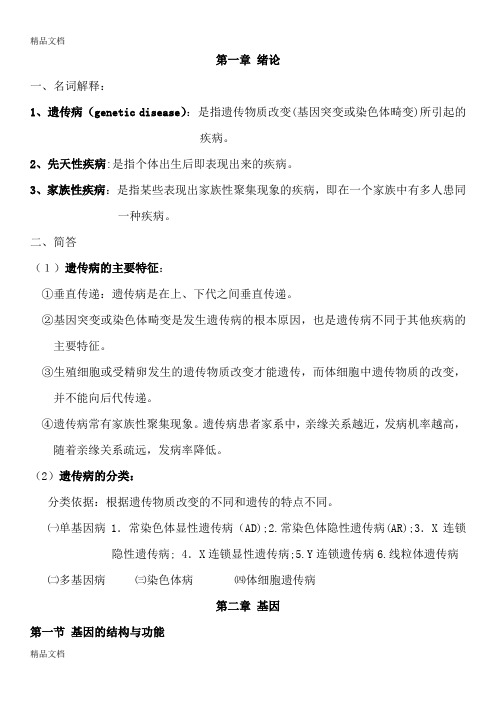
第一章绪论一、名词解释:1、遗传病(genetic disease):是指遗传物质改变(基因突变或染色体畸变)所引起的疾病。
2、先天性疾病:是指个体出生后即表现出来的疾病。
3、家族性疾病:是指某些表现出家族性聚集现象的疾病,即在一个家族中有多人患同一种疾病。
二、简答(1)遗传病的主要特征:①垂直传递:遗传病是在上、下代之间垂直传递。
②基因突变或染色体畸变是发生遗传病的根本原因,也是遗传病不同于其他疾病的主要特征。
③生殖细胞或受精卵发生的遗传物质改变才能遗传,而体细胞中遗传物质的改变,并不能向后代传递。
④遗传病常有家族性聚集现象。
遗传病患者家系中,亲缘关系越近,发病机率越高,随着亲缘关系疏远,发病率降低。
(2)遗传病的分类:分类依据:根据遗传物质改变的不同和遗传的特点不同。
㈠单基因病1.常染色体显性遗传病(AD);2.常染色体隐性遗传病(AR);3.X连锁隐性遗传病; 4.X连锁显性遗传病;5.Y连锁遗传病6.线粒体遗传病㈡多基因病㈢染色体病㈣体细胞遗传病第二章基因第一节基因的结构与功能一、名词解释:1、基因(gene):是合成一种有功能的多肽链或者RNA分子所必需的一段完整的DNA序列。
2、断裂基因:真核生物结构基因的DNA顺序包括编码顺序和非编码顺序两部分。
编码顺序在DNA分子中是不连续的,被非编码顺序分隔开,形成镶嵌排列的断裂形式,因此称为断裂基因。
3、外显子(exon):真核生物结构基因的DNA编码顺序称为外显子。
4、内含子(intron):真核生物结构基因的DNA非编码顺序称为内子。
5、多基因家族(multigene family):是指由某一共同祖先基因经过重复和变异所产生的一组基因。
根据基因在染色体的分布,可分为基因簇和基因超家族两种类型。
6、假基因(pseudogene):其基因序列与具有编码功能的基因序列类似,因为不能编码蛋白质,所以称为假基因。
2简答二、问答1、人类DNA的存在形式有哪几种?(1)高度重复顺序(卫星DNA,反向重复顺序)(2)中度重复顺序(短分散元件,长分散元件)(3)单一顺序第三节基因突变一、名词解释1、基因突变(gene mutation):是指DNA分子中的核苷酸顺序发生改变,使遗传密码编码产生相应的改变,导致组成蛋白质的氨基酸发生变化,以致引起表型的改变。
遗传学复习整理资料

遗传学复习整理资料绪论遗传学:是研究生物遗传和变异的科学。
遗传学经历了两个阶段;经典遗传学,现代遗传学遗传学经历了三个水平;个体遗传学、细胞遗传学,分子遗传学1866孟德尔,豌豆,发表“植物杂交试验”论文1910.摩尔根。
果蝇,创办了基因论,证明了基因就是在染色体上而且呈圆形线性排序1953,沃森(美)和克里克(英),提出了著名的dna双螺旋结构,三大定律:分离定律,独立分配定律,连锁遗传定律遗产研习和林木遗传改进在林业生产上的促进作用答:1.直接指导作用,如杂交引种,种子园的建立,加速育种的进程。
2.引发世界森林增加的两大因素。
不合理的砍伐制度;不合理的唐日制3.林木遗传的改进促进作用。
导致成活率低,产量提升,品质提升。
1.什么是遗传,什么是变异,有何区别与联系?答遗传――是指亲代与子代之间相似的现象。
变异――就是指亲代与子代之间、子代个体之间存有差异的现象。
遗传与与变异的辩证关系:既对立又统一,在一定条件下相互转化。
一方面,遗传使生物的性状得到继承和积累,这种继承和积累相对稳定;另一方面,变异产生新的性状,是物种不断发展演化,适应不断变化的环境。
因此,遗传不单是消极、保守的,同时也是积极的、创新的。
变异不单是负面的、消失的,也是进取的,创造的。
孟德尔遗传理论的精髓就是什么?遗传因子是独立的,呈颗粒状,互不融合,互补影响,独立分离,自由组合2.遗传学有几个主要分支,研究内容及手段?请问:经典遗传学、细胞遗传学、分子遗传学、生物统计数据遗传学3.遗传学在社会生产生活中的促进作用?答:1.在生产实践上,遗传学对农林业科学有着直接的指导作用。
2.遗传学在医学中同样起至着关键的指导作用。
人类疾病的产生及其遗传机制都须要遗传学科学知识做为指导。
3.遗传学就是人类计划生育,优生优育的理论基石。
4.遗传学在社会法制问题化解中也起著不可忽视的促进作用。
第一章形成染色体的结构单位:核小体原核细胞:只有拟核,没有细胞核和细胞器,结构较简单。
遗传学知识整理

遗传学知识整理遗传学知识整理绪论1、遗传学是研究⽣物遗传与变异规律的科学。
⽽现代遗传学是研究⽣物基因的结构与功能,基因的传递与变异,基因的表达与调控的科学。
2、变异⽣物在繁殖过程中,后代发⽣了变化,与亲代不相同的现象。
3、遗传⽣物在繁殖过程中,亲代与⼦代各⽅⾯相似的情况,本质上就是遗传信息(DNA)世代传递的现象。
4、模式⽣物这种被选定的⽣物物种就是模式⽣物。
5、遗传变异和选择是⽣物进化和新品种的选育的三⼤因素。
(看看就⾏ (1) 1856年, Mendel发现遗传因⼦的分离定律和⾃由组合定律, Mendel提出的遗传因⼦就是基因。
2) 1909年Johannsen⾸先称遗传因⼦为基因(gene) 。
3) 20世纪初, Morgan等⼈⽤果蝇做实验, 发现连锁交换定律, 并建⽴染⾊体学说, 确定基因在染⾊体上直线排列 , 染⾊体是基因的载体。
与此同时, Emerson等⼈⽤⽟⽶做实验也得到同样的结论。
4) 20世纪30年代, Muller⽤放射性处理果蝇, 研究基因的本质, 基因决定形状的问题。
5) 20世纪40年代, Beadle和Tatum研究链饱霉, 提出“⼀个基因⼀个酶”的学说, 把基因与蛋⽩质的功能结合起来,把基因概念的发展向前推进了⼀步。
Avery, Macleod和Mccarty等⼈从肺炎双球菌转化试验中发现, 转化因⼦是DNA, ⽽不是蛋⽩质。
6) 20世纪50年代, McClintock提出基因可以转座的概念, 以后证明了跳跃基因的存在。
7) 20世纪50年代, Hershey 和Chase⽤噬菌体感染⼤肠杆菌,证明DNA是遗传物质。
Watson和Crick提出DNA双螺旋结构模型,阐明了有关基因的核⼼问题—DNA的⾃我复制。
8) 20世纪60年代, 中⼼法则提出, 三联体密码的确定, 调节基因作⽤的原理被揭⽰。
9) 20世纪70年代,基因操作技术发展起来, 基因概念进⼀步发展。
遗传学整理重点

.生物进化的三大要素是、和。
(遗传变异自然选择)2.关于遗传学,下列错误的一句是( d )。
A.遗传学是研究生物遗传、变异及其规律的一门科学B.遗传学的发展经历了奠基阶段、经典遗传学及现代遗传学三个阶段C.狭义来看,研究遗传学的目的在于指导育种实践D.孟德尔通过X射线衍射分析,提出DNA分子结构模式理论3. 发现连锁遗传现象的重要意义在于( c )A.奠定和促进了分子遗传学的发展B.推翻了混合遗传的观念C.将遗传学研究与细胞学紧密结合了起来D.发展了微生物遗传学和生化遗传学4. 被遗传学家作为研究对象的理想生物,应具有哪些特征?以下选项中属于这些特征( 5 )1. 相对较短的生命周期2. 种群中的各个个体的遗传差异较大3. 每次交配产生大量的子代4. 遗传背景较为熟悉5. 以上均是理想的特征·1.真核细胞和原核细胞的区别2.动物细胞和植物细胞的异同3.主要细胞器的功能哪些细胞结构与生物的遗传有关,为什么?2着丝粒(centromere是染色体上染色很淡的缢缩区,由一条染色体所复制的两个染色单体此部位相联系。
含有大量的异染色质和高度重复的DNA序列。
3着丝点(kinetochore)又称丝定粒,是染色体着丝粒中与纺锤丝相连接的实际位置,微管蛋白的聚合中心5各种生物的染色体数目都是恒定的,在体细胞中是成对的,在性细胞中刚不然。
超染色体。
6染色体的单线性.未经复制的染色体含有一个染色单体。
染色单体含有一条双链DNA分子与蛋白质结合后形成的一条线性、无分支染色质线。
间期DNA分子通过半保留方式复制后就产生两条完全相同的DNA分子,所以含有两条姊妹染色单体。
7染色质的不同状态:在DNA进行复制或转录时(主要在间期),必须(局部)以DNA单链状态存在,所以核小体的结构也必须解开(染色质呈松弛状态);而在细胞分裂中期,染色质呈高度螺旋化状态,并且每条染色体都呈现其固有的形态特征。
很显然这两种状态间的转换不是随机、无序的卷缩,而应该是按照一定的规律转换的。
完整版遗传学知识点归纳整理3篇

完整版遗传学知识点归纳整理
第一篇:基因与遗传物质
遗传学是研究遗传现象及其规律的一门生命科学。
通过研究基因与遗传物质,遗传学揭示了生命现象的本质,深入挖掘了基因组的细节,有助于预防和治疗遗传疾病。
一、基因的概念
基因是影响个体性状的遗传因素,是遗传信息的基本单位。
一般包括表现型、基因型、等位基因和基因座等概念。
表现型是指基因所表现的生物形态、生理特征和行为特征,如眼睛颜色、身高等。
基因型是指个体所有基因的组合情况,包括杂合和纯合等。
等位基因是指同一基因座上的不同基因,如人类的血型基因有A、B、O等等。
基因座是指基因所在的特定位置。
二、遗传物质的种类
影响个体遗传特征的遗传物质分为DNA和RNA两种。
其中,DNA是生物的主要遗传物质,RNA是DNA的重要副产物,同时在调控基因表达等方面也具有重要作用。
三、DNA的构成和作用
DNA是双链螺旋结构,由核苷酸组成,其功能是储存和传递遗传信息。
每个核苷酸由磷酸、五碳糖和核苷酸碱基组成。
碱基包括腺嘌呤、胸腺嘧啶、鸟嘌呤和胞嘧啶等,它们以不同的方式配对,形成DNA双链的特殊结构。
四、RNA的种类和作用
RNA是单链螺旋结构,由核苷酸组成,其功能是通过转录和翻
译过程制造蛋白质。
RNA按照功能和结构分为mRNA、rRNA、tRNA等。
mRNA是信使RNA,存储从DNA转录过来的遗传信息,rRNA是核糖体RNA,是蛋白质合成的主要组成部分,tRNA是
转运RNA,将氨基酸带到核糖体上,在蛋白质合成过程中起到
关键作用。
完整版遗传学知识点归纳整理
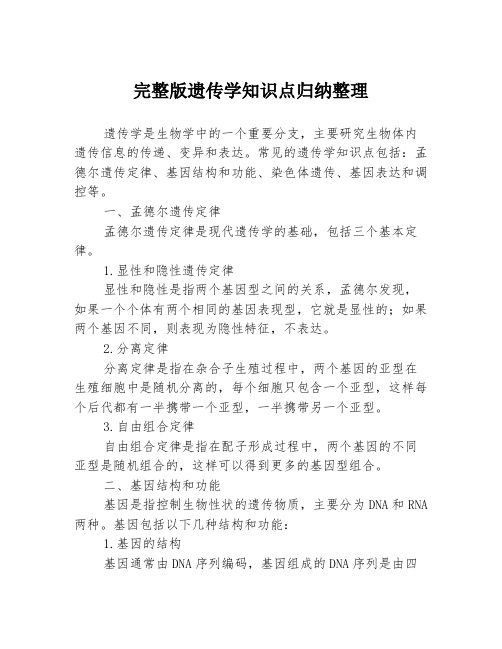
完整版遗传学知识点归纳整理遗传学是生物学中的一个重要分支,主要研究生物体内遗传信息的传递、变异和表达。
常见的遗传学知识点包括:孟德尔遗传定律、基因结构和功能、染色体遗传、基因表达和调控等。
一、孟德尔遗传定律孟德尔遗传定律是现代遗传学的基础,包括三个基本定律。
1.显性和隐性遗传定律显性和隐性是指两个基因型之间的关系,孟德尔发现,如果一个个体有两个相同的基因表现型,它就是显性的;如果两个基因不同,则表现为隐性特征,不表达。
2.分离定律分离定律是指在杂合子生殖过程中,两个基因的亚型在生殖细胞中是随机分离的,每个细胞只包含一个亚型,这样每个后代都有一半携带一个亚型,一半携带另一个亚型。
3.自由组合定律自由组合定律是指在配子形成过程中,两个基因的不同亚型是随机组合的,这样可以得到更多的基因型组合。
二、基因结构和功能基因是指控制生物性状的遗传物质,主要分为DNA和RNA 两种。
基因包括以下几种结构和功能:1.基因的结构基因通常由DNA序列编码,基因组成的DNA序列是由四个核苷酸(A、T、C、G)组成的,其中序列的排列方式决定了基因编码的蛋白质序列。
2.基因的功能基因具有不同的功能,包括编码蛋白质、调控基因表达、储存信息等。
3.基因的表达基因表达是指基因转录为RNA,然后翻译为蛋白质的过程。
基因表达可以在转录、剪切、转运、翻译以及后期修饰等环节中进行调控。
三、染色体遗传染色体是负责遗传信息的传递和复制的结构,染色体遗传主要研究染色体的结构和功能,以及染色体异常引起的遗传变异。
1.染色体结构染色体结构主要包括染色体的形态、染色体数目、染色体的组成等。
2.遗传变异在染色体遗传中,遗传变异是指基因或染色体的序列、结构或数目的改变。
最常见的遗传变异包括核型异常、染色体结构异常和单基因突变等。
四、基因表达和调控生物内部的基因表达和调控对于遗传学来说至关重要,它们包括:1.基因表达基因表达是指基因转录为RNA,然后翻译为蛋白质的过程。
高校生物专业遗传学知识梳理整理
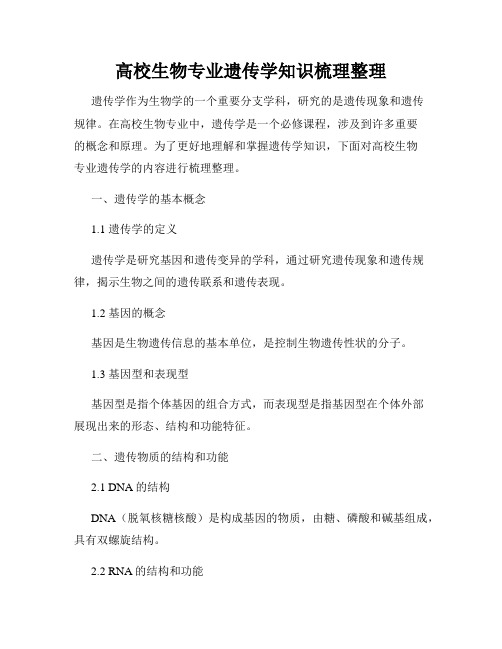
高校生物专业遗传学知识梳理整理遗传学作为生物学的一个重要分支学科,研究的是遗传现象和遗传规律。
在高校生物专业中,遗传学是一个必修课程,涉及到许多重要的概念和原理。
为了更好地理解和掌握遗传学知识,下面对高校生物专业遗传学的内容进行梳理整理。
一、遗传学的基本概念1.1 遗传学的定义遗传学是研究基因和遗传变异的学科,通过研究遗传现象和遗传规律,揭示生物之间的遗传联系和遗传表现。
1.2 基因的概念基因是生物遗传信息的基本单位,是控制生物遗传性状的分子。
1.3 基因型和表现型基因型是指个体基因的组合方式,而表现型是指基因型在个体外部展现出来的形态、结构和功能特征。
二、遗传物质的结构和功能2.1 DNA的结构DNA(脱氧核糖核酸)是构成基因的物质,由糖、磷酸和碱基组成,具有双螺旋结构。
2.2 RNA的结构和功能RNA(核糖核酸)在遗传信息的转录和翻译过程中发挥重要作用,包括mRNA、tRNA和rRNA等类型。
2.3 蛋白质的合成遗传信息从DNA转录成mRNA,然后通过翻译作用转化为蛋白质,蛋白质在细胞内起着重要的结构和功能作用。
三、遗传现象和遗传规律3.1 孟德尔的遗传规律孟德尔通过对豌豆杂交实验的观察,总结出了遗传学的基本规律,包括单因素遗传、显性和隐性等概念。
3.2 随性状的遗传规律除了孟德尔的单因素遗传规律外,还存在着多因素遗传、性别遗传和联锁性遗传等不同的遗传现象和规律。
四、遗传变异和遗传进化4.1 多态性的产生多态性是指在种群中存在多种等位基因和基因型表现出来的遗传变异现象,是遗传进化和适应性演化的基础。
4.2 突变和变异突变是指基因或染色体发生的突发性改变,而变异是指基因型在群体间或个体间的遗传差异。
4.3 选择和适应选择和适应是自然选择和人工选择对遗传变异进行筛选,使适应性较高的基因在群体中逐渐增多。
五、遗传工程和生物技术5.1 遗传工程的基本原理遗传工程利用重组 DNA 技术,将外源基因导入宿主生物体内,使其具有特定的功能或性状,包括基因克隆、转基因等技术。
遗传学部分整理复习提纲

遗传学部分整理复习提纲遗传学部分整理复习提纲第⼀章:绪论1. 最重要⼈物的贡献、年份、论著1900年,孟德尔规律的重新发现标志遗传学的诞⽣,贝特⽣发现了连锁现象,但做出了错误的解释,发现连锁与交换规律的科学家是摩尔根。
约翰⽣最先提出“基因”⼀词。
斯特蒂⽂特绘制出第⼀张遗传连锁图。
1953年,⽡特森和克⾥克提出DNA分⼦结构模式理论。
第⼆章:遗传的细胞学基础1. 重要概念:染⾊体:间期细胞核内由DNA、组蛋⽩、⾮组蛋⽩及少量RNA 组成的线性复合结构。
异染⾊质:染⾊质上染⾊深,通常不含有功能基因,在细胞周期中变化较⼩的区域,具有这种固缩特性的染⾊体。
A染⾊体:真核细胞染⾊体组的任何正常染⾊体,包括常染⾊体和性染⾊体(A染⾊体在遗传上是重要的,对个体的正常⽣活和繁殖是必需的。
其数⽬的增减和结构的变化对机体会造成严重的后果);B染⾊体:在⼀组基本染⾊体外,所含的多余染⾊体或染⾊体断⽚称为B染⾊体,它们的数⽬和⼤⼩变化很多。
⼀般在顶端都具有着丝粒,⼤多含有较多的异染⾊质。
随体:位于染⾊体次缢痕末端的、圆形或圆柱形的染⾊体⽚段。
胚乳直感(花粉直感):在3n胚乳的性状上由于精核的影响⽽直接表现⽗本的某些性状。
果实直感:种⽪或果⽪组织在发育过程中由于花粉影响⽽表现⽗本的某些性状。
⽆融合⽣殖:雌雄配⼦不发⽣核融合的⼀种⽆性⽣殖⽅式。
巨型染⾊体:⽐普通染⾊体显著巨⼤的染⾊体的总称。
有丝分裂⼀般没有同源染⾊体联会,果蝇唾腺中的多线染⾊体,染⾊质线不断复制,但是染⾊体着丝粒不分裂。
联会:在减数分裂前期过程中,同源染⾊体彼此配对的过程。
⼆价体:减数分裂前期Ι的偶线期,同源染⾊体联会形成联会复合体的⼀对染⾊体。
单价体:在特殊情况,减数分裂前期Ι的偶线期联会时,存在不能配对的染⾊体。
同源染⾊体:形态、结构和功能相似的⼀对染⾊体,⼀条来⾃⽗本,⼀条来⾃母本。
组型分析:利⽤染⾊体分带技术等,在染⾊体长度、着丝粒位置、长短臂⽐、随体有⽆特点基础上,进⼀步根据染⾊的显带表现区分出各对同源染⾊体。
医学遗传学重点整理
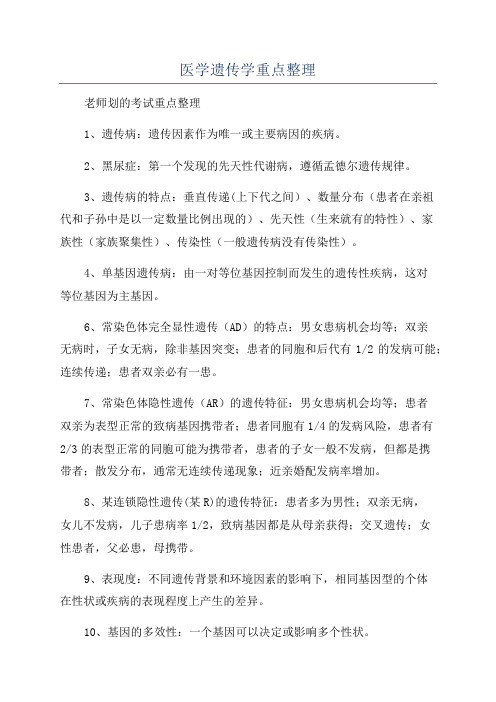
医学遗传学重点整理老师划的考试重点整理1、遗传病:遗传因素作为唯一或主要病因的疾病。
2、黑尿症:第一个发现的先天性代谢病,遵循孟德尔遗传规律。
3、遗传病的特点:垂直传递(上下代之间)、数量分布(患者在亲祖代和子孙中是以一定数量比例出现的)、先天性(生来就有的特性)、家族性(家族聚集性)、传染性(一般遗传病没有传染性)。
4、单基因遗传病:由一对等位基因控制而发生的遗传性疾病,这对等位基因为主基因。
6、常染色体完全显性遗传(AD)的特点:男女患病机会均等;双亲无病时,子女无病,除非基因突变;患者的同胞和后代有1/2的发病可能;连续传递;患者双亲必有一患。
7、常染色体隐性遗传(AR)的遗传特征:男女患病机会均等;患者双亲为表型正常的致病基因携带者;患者同胞有1/4的发病风险,患者有2/3的表型正常的同胞可能为携带者,患者的子女一般不发病,但都是携带者;散发分布,通常无连续传递现象;近亲婚配发病率增加。
8、某连锁隐性遗传(某R)的遗传特征:患者多为男性;双亲无病,女儿不发病,儿子患病率1/2,致病基因都是从母亲获得;交叉遗传;女性患者,父必患,母携带。
9、表现度:不同遗传背景和环境因素的影响下,相同基因型的个体在性状或疾病的表现程度上产生的差异。
10、基因的多效性:一个基因可以决定或影响多个性状。
11、遗传异质性:一种遗传性状可以由多个不同的遗传改变所引起。
12、限性遗传:位于常染色体上的基因,由于基因表达的性别限制,只在一种性别表现,而在另一种性别完全不能表现。
13、拟表型:由于环境因素的作用使个体产生的表型恰好与某一特定基因所产生的表型相同或相似。
14、质量性状:指单基因遗传的性状变异在群体中分布不连续,多峰。
数量性状:指多基因遗传性状变异的分布连续,呈现单峰分布,临近两个个体间差异很小。
如身高、血压。
主要取决于两点:多基因性状中多对微效基因累加效应、基因随机组合、等位基因共显性。
15、易感性:由遗传基础决定一个个体患病的风险。
医学遗传学整理
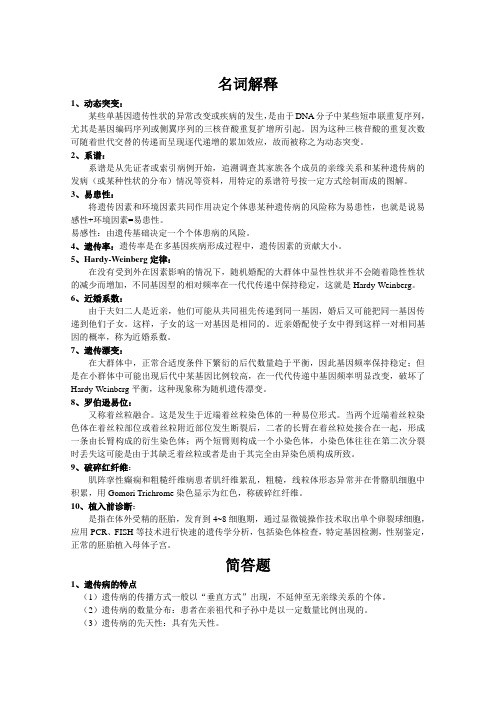
名词解释1、动态突变:某些单基因遗传性状的异常改变或疾病的发生,是由于DNA分子中某些短串联重复序列,尤其是基因编码序列或侧翼序列的三核苷酸重复扩增所引起。
因为这种三核苷酸的重复次数可随着世代交替的传递而呈现逐代递增的累加效应,故而被称之为动态突变。
2、系谱:系谱是从先证者或索引病例开始,追溯调查其家族各个成员的亲缘关系和某种遗传病的发病(或某种性状的分布)情况等资料,用特定的系谱符号按一定方式绘制而成的图解。
3、易患性:将遗传因素和环境因素共同作用决定个体患某种遗传病的风险称为易患性,也就是说易感性+环境因素=易患性。
易感性:由遗传基础决定一个个体患病的风险。
4、遗传率:遗传率是在多基因疾病形成过程中,遗传因素的贡献大小。
5、Hardy-Weinberg定律:在没有受到外在因素影响的情况下,随机婚配的大群体中显性性状并不会随着隐性性状的减少而增加,不同基因型的相对频率在一代代传递中保持稳定,这就是Hardy-Weinberg。
6、近婚系数:由于夫妇二人是近亲,他们可能从共同祖先传递到同一基因,婚后又可能把同一基因传递到他们子女。
这样,子女的这一对基因是相同的。
近亲婚配使子女中得到这样一对相同基因的概率,称为近婚系数。
7、遗传漂变:在大群体中,正常合适度条件下繁衍的后代数量趋于平衡,因此基因频率保持稳定;但是在小群体中可能出现后代中某基因比例较高,在一代代传递中基因频率明显改变,破坏了Hardy-Weinberg平衡,这种现象称为随机遗传漂变。
8、罗伯逊易位:又称着丝粒融合。
这是发生于近端着丝粒染色体的一种易位形式。
当两个近端着丝粒染色体在着丝粒部位或着丝粒附近部位发生断裂后,二者的长臂在着丝粒处接合在一起,形成一条由长臂构成的衍生染色体;两个短臂则构成一个小染色体,小染色体往往在第二次分裂时丢失这可能是由于其缺乏着丝粒或者是由于其完全由异染色质构成所致。
9、破碎红纤维:肌阵挛性癫痫和粗糙纤维病患者肌纤维絮乱,粗糙,线粒体形态异常并在骨骼肌细胞中积累,用Gomori Trichrome染色显示为红色,称破碎红纤维。
医学遗传学简答题整理

第一章1、遗传病可以分成哪几类?基因病,染色体病,体细胞遗传病三大类。
基因病又可以分为单基因和多基因病。
染色体病又可分为结构畸变和数目畸变导致的遗传病。
2、简述先天性疾病与遗传性疾病的关系?遗传性疾病指生殖细胞或受精卵的遗传物质发生异常所引起的疾病;先天性疾病指婴儿出生时就表现出来的疾病。
3、简述遗传性疾病与家族性疾病的关系?遗传性疾病指生殖细胞或受精卵的遗传物质发生异常所引起的疾病;家族性疾病指表现出有家族聚集现象的疾病。
4、单基因遗传病的研究策略有哪些?功能克隆,位置克隆,连锁分析。
5、多基因一窜并的研究策略有哪些?患病同胞对法,患者家系成员法,数量性状位点分析,生物统计模型拟合。
6、试述遗传病的主要特点?遗传病一般具有垂直传递,先天性,家族性等主要特点,在家族中的分布具有一定的比例:部分遗传病也可能因感染而发生。
7、试述疾病的发生与遗传因素和环境因素的相互关系。
①完全有遗传因素决定发病;②基本上有遗传决定,但需要环境中一定诱因的作用;③遗传因素和环境因素对发病都有作用,在不同的疾病中,在遗传度各不相同;④发病完全取决于环境因素,与遗传基本上无关。
第二章1、基因的功能主要表现在哪两个方面?①以自身为模板准确的复制出遗传信息;②通过转录和翻译,指导蛋白质合成,从而表达各种遗传性状。
2、DNA分子和RNA分子不同之处?①碱基组成不同②戊糖不同③分子结构不同3、试述DNA分子的双螺旋结构特点。
①反向平行双股螺旋②磷酸和脱氧核酸位于外侧,构成基本骨架,碱基位于内侧,以氢键相连③嘌呤=嘧啶,A与T配对G与C配对。
4、人类基因组中的功能序列可以分为哪几类?可以分为四类:单一基因,基因家族,假基因,串联重复基因。
5、DNA复制有哪些特性?互补性。
半保留性,反向平行性,不对称性,不连续性。
6、结构基因组学主要包括那几张图?遗传图,物理图,转录图,序列图。
第三章1、基因突变有哪些一般特性?多向性,可逆性,有害性,稀有性,随机性,可重复性。
遗传学重点整理
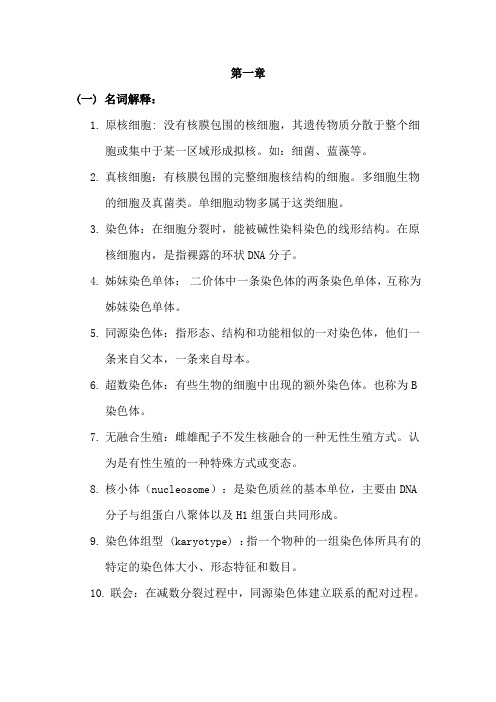
第一章(一) 名词解释:1.原核细胞: 没有核膜包围的核细胞,其遗传物质分散于整个细胞或集中于某一区域形成拟核。
如:细菌、蓝藻等。
2.真核细胞:有核膜包围的完整细胞核结构的细胞。
多细胞生物的细胞及真菌类。
单细胞动物多属于这类细胞。
3.染色体:在细胞分裂时,能被碱性染料染色的线形结构。
在原核细胞内,是指裸露的环状DNA分子。
4.姊妹染色单体:二价体中一条染色体的两条染色单体,互称为姊妹染色单体。
5.同源染色体:指形态、结构和功能相似的一对染色体,他们一条来自父本,一条来自母本。
6.超数染色体:有些生物的细胞中出现的额外染色体。
也称为B染色体。
7.无融合生殖:雌雄配子不发生核融合的一种无性生殖方式。
认为是有性生殖的一种特殊方式或变态。
8.核小体(nucleosome):是染色质丝的基本单位,主要由DNA分子与组蛋白八聚体以及H1组蛋白共同形成。
9.染色体组型 (karyotype) :指一个物种的一组染色体所具有的特定的染色体大小、形态特征和数目。
10.联会:在减数分裂过程中,同源染色体建立联系的配对过程。
11.联会复合体:是同源染色体联会过程中形成的非永久性的复合结构,主要成分是碱性蛋白及酸性蛋白,由中央成分(central element)向两侧伸出横丝,使同源染色体固定在一起。
12.双受精: 1个精核(n)与卵细胞(n)受精结合为合子(2n),将来发育成胚。
另1精核(n)与两个极核(n+n)受精结合为胚乳核(3n),将来发育成胚乳的过程。
13.胚乳直感:在3n胚乳的性状上由于精核的影响而直接表现父本的某些性状,这种现象称为胚乳直感或花粉直感。
14.果实直感:种皮或果皮组织在发育过程中由于花粉影响而表现父本的某些性状,则另称为果实直感。
简述:2.简述细胞有丝分裂和减数分裂各自的遗传学意义?答:细胞有丝分裂的遗传学意义:(1)每个染色体准确复制分裂为二,为形成两个子细胞在遗传组成上与母细胞完全一样提供了基础。
(完整版)遗传学知识点归纳(整理)3篇
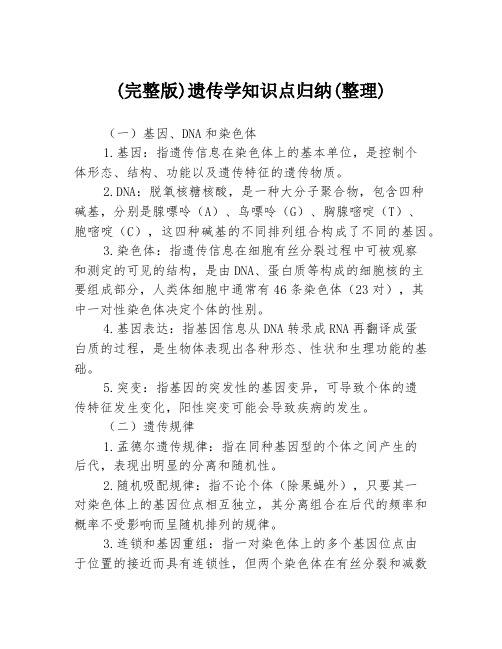
(完整版)遗传学知识点归纳(整理)(一)基因、DNA和染色体1.基因:指遗传信息在染色体上的基本单位,是控制个体形态、结构、功能以及遗传特征的遗传物质。
2.DNA:脱氧核糖核酸,是一种大分子聚合物,包含四种碱基,分别是腺嘌呤(A)、鸟嘌呤(G)、胸腺嘧啶(T)、胞嘧啶(C),这四种碱基的不同排列组合构成了不同的基因。
3.染色体:指遗传信息在细胞有丝分裂过程中可被观察和测定的可见的结构,是由DNA、蛋白质等构成的细胞核的主要组成部分,人类体细胞中通常有46条染色体(23对),其中一对性染色体决定个体的性别。
4.基因表达:指基因信息从DNA转录成RNA再翻译成蛋白质的过程,是生物体表现出各种形态、性状和生理功能的基础。
5.突变:指基因的突发性的基因变异,可导致个体的遗传特征发生变化,阳性突变可能会导致疾病的发生。
(二)遗传规律1.孟德尔遗传规律:指在同种基因型的个体之间产生的后代,表现出明显的分离和随机性。
2.随机吸配规律:指不论个体(除果蝇外),只要其一对染色体上的基因位点相互独立,其分离组合在后代的频率和概率不受影响而呈随机排列的规律。
3.连锁和基因重组:指一对染色体上的多个基因位点由于位置的接近而具有连锁性,但两个染色体在有丝分裂和减数分裂中的重组作用会破坏连锁基因,从而形成新的联合和分离组合。
4.多因素遗传规律:指人类遗传性状和疾病的发生、发展和表现受多个基因和环境因素相互作用的影响。
5.基因剪接:指在转录过程中RNA前体在剪接过程中剪下不必要的外显子以及与此同时,选择性的保留某些外显子与内含子并将其接合在一起,形成成熟RNA的过程。
(三)遗传学应用1.遗传学诊断:利用遗传学原理对个体遗传信息进行检测和分析,以确定某些遗传性状或疾病的遗传方式和危险程度。
2.基因治疗:指通过利用细胞和基因工程技术,将正常基因导入患者体内来代替缺少或异常的基因,以治疗某些遗传性疾病。
3.基因编辑:指使用CRISPR/Cas9等技术对人类基因进行修饰和编辑,可用于去除病原体基因、纠正遗传缺陷等。
(完整版)遗传学知识点归纳(整理)
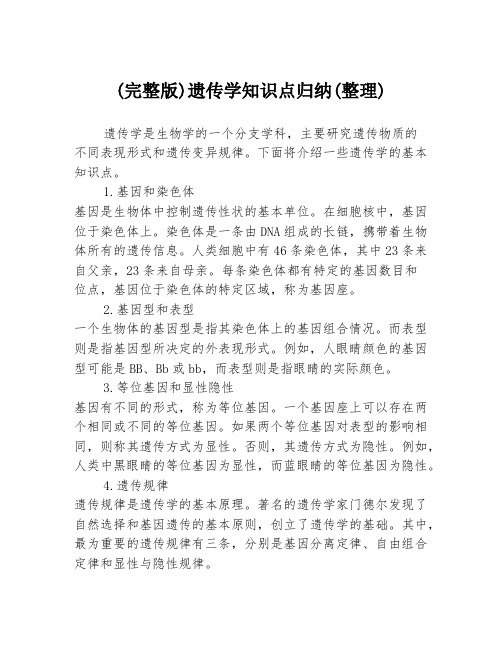
(完整版)遗传学知识点归纳(整理)遗传学是生物学的一个分支学科,主要研究遗传物质的不同表现形式和遗传变异规律。
下面将介绍一些遗传学的基本知识点。
1.基因和染色体基因是生物体中控制遗传性状的基本单位。
在细胞核中,基因位于染色体上。
染色体是一条由DNA组成的长链,携带着生物体所有的遗传信息。
人类细胞中有46条染色体,其中23条来自父亲,23条来自母亲。
每条染色体都有特定的基因数目和位点,基因位于染色体的特定区域,称为基因座。
2.基因型和表型一个生物体的基因型是指其染色体上的基因组合情况。
而表型则是指基因型所决定的外表现形式。
例如,人眼睛颜色的基因型可能是BB、Bb或bb,而表型则是指眼睛的实际颜色。
3.等位基因和显性隐性基因有不同的形式,称为等位基因。
一个基因座上可以存在两个相同或不同的等位基因。
如果两个等位基因对表型的影响相同,则称其遗传方式为显性。
否则,其遗传方式为隐性。
例如,人类中黑眼睛的等位基因为显性,而蓝眼睛的等位基因为隐性。
4.遗传规律遗传规律是遗传学的基本原理。
著名的遗传学家门德尔发现了自然选择和基因遗传的基本原则,创立了遗传学的基础。
其中,最为重要的遗传规律有三条,分别是基因分离定律、自由组合定律和显性与隐性规律。
5.遗传变异遗传变异是指个体间或群体内遗传组成差异的存在。
遗传变异并不一定表明遗传缺陷或疾病,有些变异可能使个体更适应环境,提高生存能力。
例如,一些人拥有对疾病的抗性等特殊遗传优势。
6.突变和突变模型突变是指DNA序列的改变,可导致基因表达发生异常,进而影响表型。
突变可以是自然发生的,也可以是受到化学物质、放射线等影响引起的。
突变模型则是一种定量描述突变率的数学模型,可以用于研究群体间遗传变异的规律。
7.遗传工程和生物技术遗传工程和生物技术是遗传学应用的主要领域。
遗传工程通常利用现代分子生物学技术进行基因组修饰,用于改良或创造新的品种,以满足人类需求。
而生物技术则是指利用生物体特殊的生理、代谢或分子机制进行研究或应用的技术,例如基因片段克隆、DNA测序、酶学和生物反应器工程等领域。
高中生物——遗传学知识整理
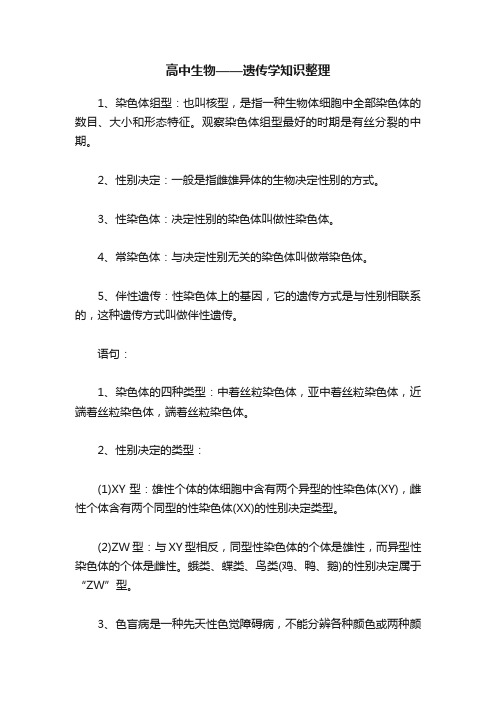
高中生物——遗传学知识整理1、染色体组型:也叫核型,是指一种生物体细胞中全部染色体的数目、大小和形态特征。
观察染色体组型最好的时期是有丝分裂的中期。
2、性别决定:一般是指雌雄异体的生物决定性别的方式。
3、性染色体:决定性别的染色体叫做性染色体。
4、常染色体:与决定性别无关的染色体叫做常染色体。
5、伴性遗传:性染色体上的基因,它的遗传方式是与性别相联系的,这种遗传方式叫做伴性遗传。
语句:1、染色体的四种类型:中着丝粒染色体,亚中着丝粒染色体,近端着丝粒染色体,端着丝粒染色体。
2、性别决定的类型:(1)XY型:雄性个体的体细胞中含有两个异型的性染色体(XY),雌性个体含有两个同型的性染色体(XX)的性别决定类型。
(2)ZW型:与XY型相反,同型性染色体的个体是雄性,而异型性染色体的个体是雌性。
蛾类、蝶类、鸟类(鸡、鸭、鹅)的性别决定属于“ZW”型。
3、色盲病是一种先天性色觉障碍病,不能分辨各种颜色或两种颜色。
其中,常见的色盲是红绿色盲,患者对红色、绿色分不清,全色盲极个别。
色盲基因(b)以及它的等位基因——正常人的B就位于X染色体上,而Y染色体的相应位置上没有什么色觉的基因。
4、色盲的遗传特点:男性多于女性一般地说,色盲这种病是由男性通过他的女儿(不病)遗传给他的外孙子(隔代遗传、交叉遗传)。
色盲基因不能由男性传给男性)。
5、血友病简介:症状——血液中缺少一种凝血因子,故凝血时间延长,或出血不止;血友病也是一种伴X隐性遗传病,其遗传特点与色盲完全一样。
DNA是主要的遗传物质1.19世纪末叶,生物学家通过对细胞的有丝分裂、减数分裂和受精过程的研究,认识到染色体在生物的遗传中具有重要的作用。
染色体的化学组成如何?到底哪种成分才是遗传物质? 染色体主要由DNA和蛋白质组成,还含有少量的RNA。
由于染色体不是单一物质组成,因而,遗传物质到底是DNA,还是蛋白质的争论相当激烈,随着噬菌体侵染大肠杆菌实验的进行,使人们普遍接受了DNA才是遗传物质的结论。
(完整版)遗传学知识点归纳(整理)

遗传学教学大纲讲稿要点第一章绪论关键词:遗传学 Genetics遗传 heredity变异 variation一.遗传学的研究特点1. 在生物的个体,细胞,和基因层次上研究遗传信息的结构,传递和表达。
2. 遗传信息的传递包括世代的传递和个体间的传递。
3. 通过个体杂交和人工的方式研究基因的功能。
“遗传学”定义遗传学是研究生物的遗传与变异规律的一门生物学分支科学。
遗传学是研究基因结构,信息传递,表达和调控的一门生物学分支科学遗传 heredity生物性状或信息世代传递的现象。
同一物种只能繁育出同种的生物同一家族的生物在性状上有类同现象变异variation生物性状在世代传递过程中出现的差异现象。
生物的子代与亲代存在差别。
生物的子代之间存在差别。
遗传与变异的关系遗传与变异是生物生存与进化的基本因素。
遗传维持了生命的延续。
没有遗传就没有生命的存在,没有遗传就没有相对稳定的物种。
变异使得生物物种推陈出新,层出不穷。
没有变异,就没有物种的形成,没有变异,就没有物种的进化,遗传与变异相辅相成,共同作用,使得生物生生不息,造就了形形色色的生物界。
二. 遗传学的发展历史1865年Mendel发现遗传学基本定律。
建立了颗粒式遗传的机制。
1910年Morgan建立基因在染色体上的关系。
1944年Avery证明DNA是遗传物质。
1951年Watson和Crick的DNA构型。
1961年Crick遗传密码的发现。
1975年以后的基因工程的发展。
三. 遗传学的研究分支1. 从遗传学研究的内容划分进化遗传学研究生物进化过程中遗传学机制与作用的遗传学分支科学生物进化的机制突变和选择有害突变淘汰和保留有利突变保留与丢失中立突变 DNA多态性发育遗传学研究基因的时间,空间,剂量的表达在生物发育中的作用分支遗传学。
特征:基因的对细胞周期分裂和分化的作用。
应用重点干细胞的基因作用。
转基因动物克隆动物免疫遗传学研究基因在免疫系统中的作用的遗传学分支。
《医学遗传学》重点整理
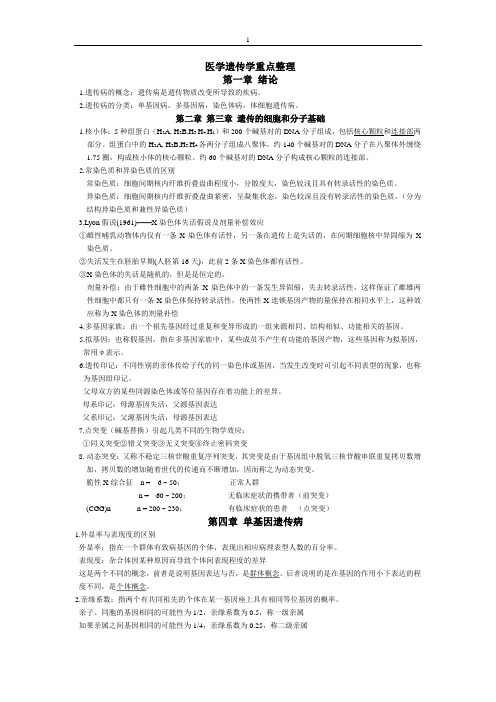
医学遗传学重点整理第一章绪论1.遗传病的概念:遗传病是遗传物质改变所导致的疾病。
2.遗传病的分类:单基因病,多基因病,染色体病,体细胞遗传病。
第二章第三章遗传的细胞和分子基础1.核小体:5种组蛋白(H2A, H2B,H3,H4,H1)和200个碱基对的DNA分子组成,包括核心颗粒和连接部两部分。
组蛋白中的H2A, H2B,H3,H4各两分子组成八聚体,约140个碱基对的DNA分子在八聚体外缠绕1.75圈,构成核小体的核心颗粒。
约60个碱基对的DNA分子构成核心颗粒的连接部。
2.常染色质和异染色质的区别常染色质:细胞间期核内纤维折叠盘曲程度小,分散度大,染色较浅且具有转录活性的染色质。
异染色质:细胞间期核内纤维折叠盘曲紧密,呈凝集状态,染色较深且没有转录活性的染色质。
(分为结构异染色质和兼性异染色质)3.Lyon假说(1961)——X染色体失活假说及剂量补偿效应①雌性哺乳动物体内仅有一条X染色体有活性,另一条在遗传上是失活的,在间期细胞核中异固缩为X染色质。
②失活发生在胚胎早期(人胚第16天),此前2条X染色体都有活性。
③X染色体的失活是随机的,但是是恒定的。
剂量补偿:由于雌性细胞中的两条X染色体中的一条发生异固缩,失去转录活性,这样保证了雌雄两性细胞中都只有一条X染色体保持转录活性,使两性X连锁基因产物的量保持在相同水平上,这种效应称为X染色体的剂量补偿4.多基因家族:由一个祖先基因经过重复和变异形成的一组来源相同、结构相似、功能相关的基因。
5.拟基因:也称假基因,指在多基因家族中,某些成员不产生有功能的基因产物,这些基因称为拟基因,常用ψ表示。
6.遗传印记:不同性别的亲体传给子代的同一染色体或基因,当发生改变时可引起不同表型的现象,也称为基因组印记。
父母双方的某些同源染色体或等位基因存在着功能上的差异。
母系印记:母源基因失活,父源基因表达父系印记:父源基因失活,母源基因表达7.点突变(碱基替换)引起几类不同的生物学效应:①同义突变②错义突变③无义突变④终止密码突变8.动态突变:又称不稳定三核苷酸重复序列突变,其突变是由于基因组中脱氧三核苷酸串联重复拷贝数增加,拷贝数的增加随着世代的传递而不断增加,因而称之为动态突变。
- 1、下载文档前请自行甄别文档内容的完整性,平台不提供额外的编辑、内容补充、找答案等附加服务。
- 2、"仅部分预览"的文档,不可在线预览部分如存在完整性等问题,可反馈申请退款(可完整预览的文档不适用该条件!)。
- 3、如文档侵犯您的权益,请联系客服反馈,我们会尽快为您处理(人工客服工作时间:9:00-18:30)。
Glossary for Medical Genetics◆Allele: one of the alternative versions of a gene or DNA sequence at a given locus.◆Allele-specific oligonucleotide (ASO): an oligonucleotide probe synthesized to match a particular DNAsequence precisely and allow the discrimination of alleles than differ by only a single base.◆Allelic heterogeneity: in a population, there may be a number of different mutant alleles at a single locus. Inan individual, the same or similar phenotype may be caused by different mutant alleles rather than by identical alleles at the locus. (血红蛋白基因突变)◆Locus heterogeneity: the production of identical phenotypes by mutants at two or more different loci.(e.g.Retinitis pigmentosa视网膜色素变性/先天性聋哑)◆Amniocentesis:a procedure used in prenatal diagnosis to obtain amniotic fluid, which contains cells of fetalorigin that can be cultured for analysis. Amniotic fluid is withdrawn from the amniotic sac by syringe after insertion of a hollow needle into the amnion through the abdominal wall and uterine wall.◆Aneuploidy: any chromosome number that is not an exact multiple of the haploid number. The common formsof aneuploidy in humans are trisomy and monosomy.◆Haploid: the chromosome number of normal gamete, with only one member of each chromosome pair. Inhumans, the haploid number is 23.◆Haploinsufficiency: a cause of genetic disease in which the contribution from a normal allele is insufficient toprevent disease because of a loss-of –function mutation at the other allele.◆Haplotype: a group of alleles in coupling at closely linked loci, usually inherited as a unit.◆Hapmap: a set of haplotypes, defined by tag SNPs, distributed throughout the genome, used for associationstudies.◆Anticipation: the progressively earlier onset and increased severity of certain diseases in successivegenerations of a family. Anticipation is caused by expansion of the number of unstable repeats within the gene responsible for the disease.◆Heterochromatin:chromatin that stains darkly throughout the cell cycle, even in interphase generally thoughtto be late replicating and genetically inactive. Satellite DNA in regions such as centromeres, acrocentric short arms, and 1qh, 9qh, 16qh, and Yqh constitutes constitutive hetertochromatin, whereas the chromatin of inactive X chromosome is referred to as facultative heterochromatin.◆Antisense strand of DNA: the non-coding DNA strand, which is complementary to mRNA and serves as thetemplate for RNA synthesis. Also called the transcribed strand.◆Association: in genetic epidemiology, describes the situation in which a particular allele is found eithersignificantly more or significantly less frequently in a group of affected individuals than would be expected from the frequency of allele in the general population from which the affected individuals were drawn.◆Autosome: any nuclear chromosome other than the sex chromosomes;22 pairs in the human karyotype. Adisease caused by mutation in an Autosome gene or gene pair shows autosomal inheritance.◆Balanced polymorphism: a polymorphism maintained in the population by heterozygote advantage, allowingan allele, even one that is deleterious in the homozygous state, to persist at a relatively high frequency in the population.◆Carrier: an individual heterozygous for a particular mutant allele. The term is used for heterozygote forautosomal recessive alleles, for females heterozygous for X-linked alleles, or, less commonly, for an individual heterozygous for an autosomal dominant allele but not expressing it (e.g. a heterozygote for a Huntington disease allele in the pre-symptomatic stage).◆Centromere: the primary constriction on the chromosome, a region at which the sister chromatids are heldtogether and at which the kinetochore is formed. Required for normal segregation in mitosis and meiosis.◆Chorionic villus sampling(CVS): 绒毛细胞取样◆Chromatin: the complex of DNA and proteins of which chromosomes are composed.◆Chromosome painting probe: a multi-locus probe designed for fluorescence in situ hybridization (FISH) thathybridizes to only one particular chromosome or chromosome arm. (染色体涂染探针:用于荧光原位杂交的多基因座探针)◆Dominant negative: a disease-causing allele, or the effect of such an allele, that disrupts the function of awild-type allele in the same cell.◆Euchromatin:the major component of chromatin, it stains lightly with G banding, decondensing andbecoming light-staining interphase .◆Expressivity: the extent to which a genetic defect is expressed. If there is variable expressivity, the trait mayvary in expression from mild to severe but is never completely unexpressed in individuals who have the corresponding genotype.◆Penetrance:the fraction of individuals with a genotype known to cause a disease who have any signs orsymptoms of the disease.◆Founder effect: a high frequency of a mutant allele in a population founded by a small ancestral group whenone or more of the founders was a carrier of the mutant allele.◆Frameshift mutation: a mutation involving a deletion or insertion that is not an exact multiple of tree basepairs and thus changes the reading frame of the gene downstream of the mutation.◆Gatekeeper gene: tumor-suppressor genes that directly regulate cell proliferation.看门基因◆Housekeeping genes: genes expressed in most or all cells because their products provides basic functions. 持家基因◆Gene pool: all the alleles present at a given locus◆Genetic drift: random fluctuation of allele frequencies in small populations.◆Genetic map: the relative positions of the genes on the chromosomes, as shown by linkage analysis.◆Genome: the complete DNA sequence, containing the entire genetic information, of a gamete, an individual, apopulation, or a species.◆Imprinting: the phenomenon of different expression of alleles depending on the parent of origin.◆Inborn error of metabolism: a genetically determined biochemical disorder in which a specific protein defectproduces a metabolic block that may have pathological consequences.◆Karyotype: the chromosome constitution of an individual.the term is also used for a photomicrograph of thechromosomes of an individual systematically arranged and for the process of preparing such a photomicrograph.◆Linkage disequilibrium: the occurrence of specific combinations of alleles in coupling phase at two or morelinked loci more frequently than expected by chance from the frequency of the alleles in the population.◆Loss of heterozygosity: LOH loss of normal allele from a region of one chromosome of a pair, allowing adefective allele on the homologous chromosome to be clinically manifest. A feature of many causes of retinoblastoma, breast cancer and other tumors due to mutation in a tumor-suppressor gene.◆Manifesting heterozygote◆Mitochondrial bottleneck: a step in oogenesis in which only a small sample of the total number ofmitochondria in an oocyte precursor is passed on to daughter cells, thereby allowing significant variation in the proportions of mutant and wild-type mitochondrial inherited by the daughter cells.◆Chimera异源嵌合体Mosaic 同源嵌合体◆Nonsense mutation:a single-base substitution in DNA resulting in a chain-termination codon.◆Oncogene:a dominantly acting gene responsible for tumor development. Mutation , over- expression , oramplification of oncogenes in somatic cells may lead to neoplastic transformation. Contrast with proto-oncogene and with tumor-suppressor gene.◆Pedigree: in medical genetics,a family history of a hereditary condition, or a diagram of a family historyindicating the family members, their relationships to the proband, and their status with respect to a particular hereditary condition.◆Philadelphia chromosome(Ph) : the structurally abnormal chromosome 22 that typically occurs in aproportion of the bone marrow cells in most patients with chronic myelogenous leukemia. The abnormality isa reciprocal translocation between the distal portion of 22q and the distal portion of 9q.◆Pleiotropy:multiple phenotypic effects of a single allele or pair of allels.◆Proband:the affected family member through whom the family is ascertained.◆Quantitative trait: a measurable quantity that differs among different individuals, often following a normaldistribution in the population.◆RFLP: a polymorphism difference in DNA sequence between individuals that can be recognized by restrictionendonucleases.◆STRP: 短串联重复序列多态性a polymorphic locus consisting of a variable number of tandemly repeatedbinucleotide, trinucleotide or tetranucleotide units such as (TG)n, (CAA)n, (GA TA)n; 又称微卫星标记◆SNP: single nucleotide polymorphism :a polymorphism in DNA sequence consisting of variation in a singlebase.◆VNTR(可变数目串联重复序列): a type of DNA polymorphism created by a tandem arrangement of multiplecopies of short DNA sequences. Highly polymorphic, used in linkage studies and DNA “finger printing”for paternity testing and forensic medicine.◆Tag SNPs: a select, minimal subset of all the SNPs in a genomic region ,chosen because they are in linkagedisequilibrium with one another in the population. Tag SNPs are useful because they form a minimum set of SNPs whose alleles constitute haplotypes capable of representing all the common haplotypes in that region.◆Telomere: the end of each chromosome arm. Human telomeres end with tandem copies of the sequence(TTAGGG)n, which is required for the proper replication of chromosome end.◆Tumor-suppressor gene: a normal gene involved in the regulation of cell proliferation. Recessive mutationcan lead to tumor development ,as in the retinoblastoma gene or the p53 gene. Contrast with oncogene.基因诊断(间接分析)单核苷突变的检测:限制性内切酶谱分析ASOASA(allele-specific amplification)PCR-SSCP(PCR-single strand conformation polymorphism analysis) PCR-单链构象多态性分析变性梯度凝胶电泳(denaturing gradient gel eletrophoresis, DGGE) (A-T丰富的部位DNA双链容易分开,其中错配碱基更易分开)熔点曲线分析(melting curve analysis)直接DNA测序生物芯片:基因芯片、蛋白芯片、芯片实验室高通量、微型化、自动化Prader- Willi Syndrome 父源缺失(15q11-15q13)Angelman Syndrome 母源缺失(15q11-15q13)Beckwith-Wiedemann Syndrome (11p15) (单亲二体):very large at birth, enlarged tongue, frequent protrusion of the umbilicusDown Syndrome(trisomy 21)Trisomy 18(Edwards Syndrome) :mental retardation and failure to thrive, malformation of heart,手成特殊握掌姿势;摇椅样畸形足Trisomy 13:(Patau Syndrome)Cri du Chat Syndrome: 5p15 deletionKline felter Syndrome: 47XXY 被报道的第一种人类性染色体病47 XYY47XXX45 XO Turner SyndromeFragile X chromosome Syndrome, fra X 通过女性传递会使儿子CGG序列增加患病几率提高染色体微缺失综合征:Wilms瘤(11p13) 、视网膜母细胞瘤(13q14.11)、Prade-Willi 综合征(15q11-12 paternal)、Angelman综合征(15q11-12 maternal)、Duchenne肌营养不良(Xq21)AD:Huntington chorea: (CAG)n duplication 4p16.3 parental imprintingMarfan syndrome: fibrillin原纤蛋白abnormal 15q21.3Achondroplasia ,ACH :FGFR3缺陷4p16.3NF1(neurofibromatosis )Osteogenesis imperfecta type 1 成骨发育不全1型I型胶原a链异常ARCystic fibrosis :7q31.2Xeroderma pigmentosum,XP: DNA 切除修复功能受损9q34.1Sickle cell anemiaAlbinism:PKU1:12q22-q24.1 PAH insufficiencyXDX-linked hypophosphatemia rickets,XLH 抗维生素D佝偻病XRDMD:(or pseduohypertrophic muscular dystrophy) 人类最大基因79exons Xp21.2-21.3Y-linked inheritance亲缘系数:隐性遗传病越是少见,近亲结婚所生患儿相对风险率越高。
